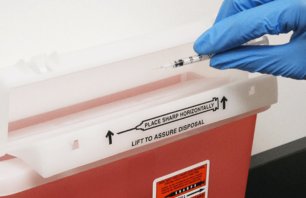Wrapping Your Head Around Pharmaceutical Waste Management
For healthcare organizations, throwing away unused and expired medications is not as simple as staff tossing them in a nearby waste container. Some medications are considered hazardous by the EPA and/or other regulatory entities and must be separated from other drugs to preserve staff and patient safety and prevent inadvertent environmental contamination. For example, drugs that fall under the purview of the Resource Conservation and Recovery Act (RCRA) require different handling and disposal to be compliant with Environmental Protection Agency (EPA) and Department of Transportation (DOT). Similarly, controlled substances must be carefully disposed to avoid diversion and other potential negative consequences.
Key Strategies for Compliant Pharmaceutical Waste Disposal
Use Medical Waste Disposal Best Practices
It is important to have designated containers for distinct types of pharmaceutical waste. Sometimes, depending on whether the facility uses an automated dispending machine, facilities will need to determine whether they’ll overclassify all of their pharmaceutical waste as RCRA, or if they’ll segregate the RCRA from the non-RCRA waste. Even within the RCRA waste designation, there may need to be further segregation if drugs are incompatible with other medications. Controlled substances should go into alternate containers, as should any chemotherapy drugs.
Choosing a specific color scheme for the different containers can be beneficial, so staff can clearly identify which ones hold certain types of waste. Waste containers should be kept in authorized areas and closed at all times when not in use.
Provide Staff with Pharmaceutical Waste Disposal Training
Your employees must be fully knowledgeable and up-to-date about what types of pharmaceutical waste your facility has and where and how they should dispose of it. Understanding the correct quantity, size and type of pharmaceutical waste container to use is essential.
Staff training should occur during orientation, as well as a part of annual refreshers. The time and dates of training should be documented.
Choose an Expert Healthcare Waste Management Partner
Keeping track of all of the applicable rules and regulations associated with regulated medical waste can be challenging, and it is helpful to work with a knowledgeable partner who can untangle the complexities. A company like Stericycle, which specializes in healthcare waste management, can provide focused information about pharmaceutical waste requirements based on your formulary. We also recommend the appropriate number and type of pharmaceutical waste containers depending on your facility’s unique needs.
In addition, we can conduct in-person consultations, develop customized compliance checklists and supply you with targeted educational materials. Our online training modules give your staff ready access to complete training, which is automatically documented when the employee completes a module.
Stericycle also ensures proper disposal and incineration once the waste leaves your facility. We are in compliance with the EPA and DOT to transport and dispose of pharmaceutical waste at licensed storage and disposal facilities.
The key to compliant and effective pharmaceutical waste management is a dynamic partnership with an expert. Learn how we can help you set up and maintain a comprehensive program.


